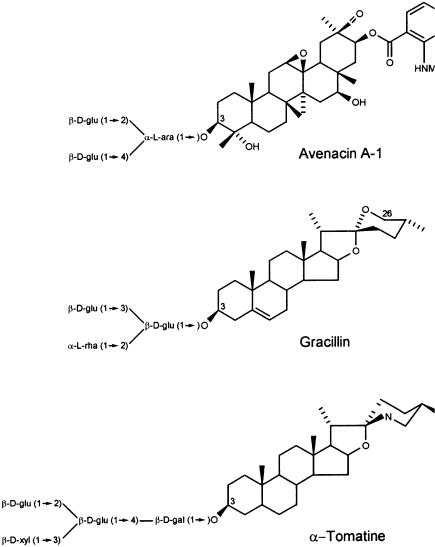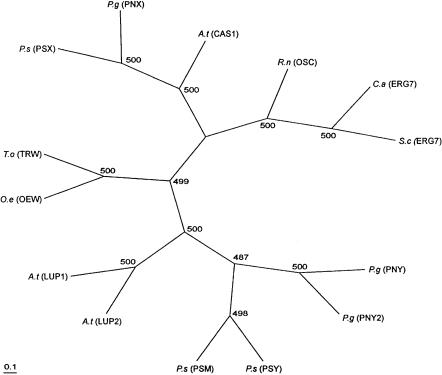
History of Modern Genetics in Germany
.pdf32 |
K. Haralampidis et al. |
3Elaboration of the Aglycone . . . . . . . . . . . . . . . . . . . . . . . 44
3.1 Saponin Glycosyltransferases . . . . . . . . . . . . . . . . . . . . . . |
45 |
4Conclusions . . . . . . . . . . . . . . . . . . . . . . . . . . . . . . . . 46
5References . . . . . . . . . . . . . . . . . . . . . . . . . . . . . . . . 47
List of Abbreviations
aAS |
a-Amyrin synthase |
bAS |
b-Amyrin synthase |
CS |
Cycloartenol synthase |
DS |
Dammarenediol synthase |
EST |
Expressed sequence tag |
LS |
Lanosterol synthase |
LuP |
Lupeol synthase |
OSC |
Oxidosqualene cyclase |
PCR |
Polymerase chain reaction |
SC |
Squalene-hopene cyclase |
1 Introduction
Collectively plants synthesise a diverse array of secondary metabolites, either as part of normal growth and development or in response to pathogen attack or stress. By definition, secondary metabolites are regarded as “luxury items” that are not required for growth and reproduction of the plant,at least under defined conditions. Since the ability to synthesise particular classes of secondary metabolites is restricted to certain plant groups, these compounds are clearly not essential for survival. However they may be important in conferring selective advantages, for example by suppressing the growth of neighbouring plants or by protecting against pests, pathogens and stress [1–5]. They may also have subtle physiological roles in plants,which are as yet uncharacterised. In addition to their natural roles plant secondary metabolites also represent a vast resource of complex molecules that are valued and exploited by man for their pharmacological and other properties [1].
Saponins are an important group of plant secondary metabolites that are widespread throughout the Plant Kingdom [4, 6–9]. The name saponin is derived from sapo, the Latin word for soap, since these molecules have surfactant properties and give stable, soap-like foams in aqueous solution. Chemically, the term saponin has become accepted to define a group of structurally diverse molecules that consists of glycosylated steroids, steroidal alkaloids and triterpenoids (Fig. 1). These secondary metabolites often occur in plants as complex mixtures, and saponin content and composition may vary markedly depending on the genetic background of the plant material, the tissue type, the age and physiological state of the plant and environmental factors [6–10].

Biosynthesis of Triterpenoid Saponins in Plants |
33 |
A
B
C
Fig. 1 A – C. Examples of different classes of saponins: A the triterpenoid saponin avenacin A-1 from roots of Avena spp; B the steroidal saponin gracillin, from Costus speciosus; C the steroidal glycoalkaloid a-tomatine from tomato (Lycopersicon spp.)
Saponins have been variously attributed with a diverse range of properties, some of which include both beneficial and detrimental effects on human health, piscidical, insecticidal and molluscicidal activity, allelopathic action, antinutritional effects, sweetness and bitterness, and as phytoprotectants that defend plants against attack by microbes and herbivores [2–11]. A more detailed understanding of the biochemical pathways and enzymes involved in saponin

34 |
K. Haralampidis et al. |
biosynthesis will facilitate the development of plants with altered saponin content. In some cases enhanced levels of saponins or the synthesis of novel saponins may be desirable (for example, for drug production [9, 12–15] or improved disease resistance [4, 6, 10, 16]) while for other plants reduction in the content of undesirable saponins would be beneficial (for example, for legume saponins that are associated with antifeedant properties in animal feed [8]).This review is concerned with recent progress that has been made in the characterisation of the enzymes and genes involved in the synthesis of these complex molecules, and focuses on triterpenoid saponins.
2
Cyclization of 2,3-Oxidosqualene – The First Committed Step in Triterpenoid Biosynthesis
The first committed step in the synthesis of triterpenoid saponins involves the cyclisation of 2,3-oxidosqualene to give one of a number of different potential products [9]. Most plant triterpenoid saponins are derived from oleanane or dammarane skeletons, although lupanes are also common [9]. This cyclisation event forms a branchpoint with the sterol biosynthetic pathway,in which 2,3-ox- idosqualene is cyclised to lanosterol (in animals and fungi) or to cycloartenol (in plants) (Fig. 2). Sterols are important membrane constituents and also serve as precursors for hormone biosynthesis.
The cyclisation, rearrangement and deprotonation reactions leading to the different products shown in Fig. 2 (originally proposed by the “biogenetic isoprene rule”) are well established [17–20]. Enzymatic cyclisation of 2,3-oxi- dosqualene into sterols proceeds in the“chair-boat-chair”conformation to yield the C-20 protosteryl cation, which is then converted to cycloartenol or lanosterol. These cyclisation events are catalysed by the 2,3-oxidosqualene cyclases (OSCs) cycloartenol synthase (CS) and lanosterol synthase (LS), respectively. Triterpenoid synthesis, on the other hand, involves cyclisation of the “chair- chair-chair” conformation of the substrate to give the tetracyclic dammarenyl cation. This cation may then be converted to dammarene-like triterpenoids by the OSC dammarenediol synthase (DS), or may undergo further rearrangements leading to the formation of pentacyclic triterpenoids derived from lupeol, b-amyrin and a-amyrin (Fig. 2). The 2,3-oxidosqualene cyclases (OSCs) that mediate these different cyclisation events are listed in Table 1.
Table 1. 2,3-Oxidosqualene cyclases
Enzyme |
Abbreviation |
EC Number |
Organism |
|
|
|
|
Lanosterol synthase |
LS |
EC 5.4.99.7 |
Animals, Fungi |
Cycloartenol synthase |
CS |
EC 5.4.99.8 |
Plants |
Dammarenediol synthase |
DS |
– |
Plants |
a-Amyrin synthase |
aAS |
EC 5.4.99 |
Plants |
b-Amyrin synthase |
bAS |
EC 5.4.99 |
Plants |
Lupeol synthase |
LuS |
EC 5.4.99 |
Plants |
|
|
|
|

Fig. 2. Cyclization of 2,3-oxidosqualene to sterols and triterpenoids. The 2,3-oxidosqualene cyclase enzymes that catalyse the formation of the different products are indicated: LS, lanosterol synthase; CS, cycloartenol synthase; DS, dammarenediol synthase; LuS, lupeol synthase; bAS, b-amyrin synthase; aAS, a-amyrin synthase
Plants in Saponins Triterpenoid of Biosynthesis
35
36 |
K. Haralampidis et al. |
The mechanisms by which 2,3-oxidosqualene is cyclised to a diverse range of products has been a source of intrigue for nearly half a century,and the enzymes that catalyse these reactions are of great interest both to biochemists and to industry. LS enzymes have commercial importance as targets for the development of antifungal [21] and cholesteremic drugs [21, 22]. Since the cyclisation of 2,3- oxidosqualene to sterols and triterpenoids represents a branchpoint between primary and secondary metabolism, plant OSCs are also attractive tools for investigating the regulation of synthesis and the physiological role of triterpenoids, and potentially for manipulation of sterol and triterpenoid content [23–26]. Recent progress in the purification of OSCs and in the cloning and analysis of the corresponding genes has given us substantial insight into the relationship between the nature of the cyclisation event and enzyme structure, and distinct subgroups of enzymes that mediate the conversion of 2,3-oxi- dosqualene to different cyclisation products are now emerging.Advances in this area are summarised below.
2.1
Resolution of Cyclase Activities Required for Sterol and Triterpenoid Biosynthesis
A key question in understanding triterpenoid biosynthesis has centred around whether the generation of different cyclisation products from 2,3-oxidosqua- lene involves distinct oxidosqualene cyclase enzymes, or whether these reactions may be mediated by a single enzyme, the product specificity of which may be determined by protein modification or by factors such as electrolyte concentration [23, 27, 28]. In pea (Pisum sativum), b-amyrin production is very active during development and just after germination, while sterol biosynthesis increases several days after germination [23]. Similar changes in triterpenoid and steroid biosynthesis in developing seed have been reported for the monocot Sorghum bicolor suggesting that this may be a common phenomenon in different plant species [29], although the significance of this dramatic switch between sterol and triterpenoid synthesis is unclear. The levels of b-amyrin synthase (bAS) and cycloartenol synthase (CS) activities in germinating pea seedlings alter during development in parallel with the changes in sterol and triterpenoid content, suggesting that the two enzymes are likely to be distinct proteins [27].
CS and bAS enzymes have been fully purified from seedlings of pea [27, 30, 31] and also from microsomes of cell suspension cultures of another plant species, Rabdosia japonica [32]. The purified pea CS and bAS enzymes were identified as 55-kDa and 35-kDa proteins, respectively [27, 30, 31]. Similarly CS and bAS enzymes purified from R. japonica were also found to be distinct protein species with molecular masses of 54 kDa and 28 kDa, respectively [32]. The two classes of OSC also show differences in sensitivity to inhibitors and detergents [27,32].Taken together,this information suggested that the two cyclisation reactions were carried out by different enzymes. However, in the absence of amino acid sequence information the possibility remained that the enzymes represented different forms of a single gene product. The cloning and characterisation of genes encoding OSCs was required to resolve this.
Biosynthesis of Triterpenoid Saponins in Plants |
37 |
2.2
Cloning of 2,3-Oxidosqualene Cyclases
2.2.1
OSCs Required for Sterol Biosynthesis
In general, purification of OSCs in sufficient quantity for amino acid sequence determination or antibody production has proved to be difficult due to the small amounts of protein and the problems of obtaining the solubilised enzyme in an active state [20, 27, 33, 34], and so attempts to isolate cDNA clones or genes encoding OSCs by these routes have met with only limited success. However,amino acid sequence information from purified OSCs has been used successfully in reverse genetics approaches to isolate cloned cDNAs for LS from animals and fungi. For example, the cDNA encoding rat LS was cloned in this way [34, 35]. The LS genes from Candida albicans and Saccharomyces cerevisiae have both been cloned using a different strategy that involved genetic complementation of an LS-deficient (erg7) mutant of S. cerevisiae [36–38].
Yeast does not synthesise cycloartenol or triterpenes, and so approaches to clone plant OSCs by complementation in S. cerevisiae are not feasible because of the lack of appropriate mutants. However, LS-deficient yeast mutants accumulate high levels of 2,3-oxidosqualene,favouring the synthesis of novel cyclisation products generated by heterologous expression of OSCs. The absence of lanosterol also facilitates analysis of the reaction products. Corey and co-workers isolated a cDNA encoding Arabidopsis thaliana CS by transforming a plant cDNA expression library into such a yeast mutant and screening protein preparations derived from pools of transformants for the ability to synthesise cycloartenol by TLC [39].
The availability of an increasing amount of DNA sequence information for LS and CS enzymes enabled regions of highly conserved amino acids to be identified in their predicted amino acid sequences. The cDNAs encoding LS from yeast, humans and rat have been cloned by polymerase chain reaction (PCR) amplification using degenerate oligonucleotide primers corresponding to such regions [40, 41]. The P. sativum CS cDNA was also isolated in this way [42]. The functions of cDNAs that are predicted to encode OSCs have generally been confirmed by expression in LS-deficient yeast strains. Cycloartenol does not normally accumulate in sufficient amounts to be detected by TLC or HPLC in yeast extracts (probably due to metabolic conversion of cycloartenol by the yeast strain [12, 43]) and so assays for cycloartenol synthase activity are usually carried out in vitro using [3H]oxidosqualene as the substrate.
2.2.2
Triterpenoid Cyclases
An important step was made when the conservation between the predicted amino acid sequences of cloned and characterised LS and CS enzymes was used to isolate two cDNA clones that were predicted to encode OSCs from Panax ginseng [12]. Expression of the full-length cDNAs in yeast indicated that one of the
38 |
K. Haralampidis et al. |
clones encoded CS, while the other encoded bAS. Triterpenoid products generated by heterologous expression of OSCs in yeast are not readily metabolised, and so can be detected by analysis of cell extracts by TLC or reverse-phase HPLC. The deduced amino acid sequence of the P. ginseng bAS is 60% identical to that of the CS enzyme, suggesting that the enzymes may share a common ancestral origin.A second bAS has also been cloned from P. ginseng [14]. The subsequent cloning of cDNAs encoding a-/b-amyrin cyclase enzymes from pea [44], LuS enzymes from Olea europaea and Taraxacum officinale [45], and multifunctional triterpene synthases from Arabidopsis thaliana [46–48], confirmed that there is overall structural relatedness between the LS and CS enzymes of sterol biosynthesis and the OSCs that mediate the cyclisation of 2,3-oxidosqua- lene to triterpenoids.However,the triterpenoid cyclases are clearly distinct from LS and CS enzymes, and form discrete subgroups within the OSC superfamily.
2.2.3
OSC Gene Families
Benveniste et al. have carried out the first comprehensive analysis of OSCs in a single plant species by screening A. thaliana EST databases and cDNA libraries and have identified 3 cDNAs encoding OSCs [47]. The function of these has been investigated by expression in yeast. One (ATLUP1) was identical to an LuS isolated from A. thaliana by Matsuda and co-workers [46], which synthesises primarily lupeol in yeast [46, 47]. ATLUP1 also forms other minor triterpene products including b-amyrin in yeast [46, 47, 49] and because it is more closely related to the P. ginseng bAS enzymes than to the LuS enzymes from Olea europaea and Taraxacum officinalis it has been suggested that in the plant the primary product of ATLUP1 may be b- or a-amyrin or other triterpenoids [47, 49]. The second cDNA (ATLUP2) encoded a multifunctional enzyme that catalysed the production of lupeol, b- and a-amyrin in the ratio 15:55:30 [47,48].A third predicted OSC (ATPEN1) was also introduced into yeast but no triterpenoid products were detected.A survey of Arabidopsis genomic sequence information identified five genes belonging to the subfamily of OSCs that contained ATLUP1 and ATLUP2, and seven genes that were closely related to ATPEN1. The functions of these triterpenoid cyclases in A. thaliana are as yet unknown. A. thaliana does not appear to synthesise saponins, but a- and b-amyrin and lupeol are present in extracts of leaves and callus of the plant [47]. It is possible that triterpenoids and their derivatives may play important roles in plant growth and development.
2.3
The Relationship Between Structure and Function
OSCs that have been functionally characterised by expression in yeast are listed in Table 2, and the relatedness between the amino acid sequences of these enzymes is illustrated in Fig. 3. The conserved features of this OSC superfamily and the differences between them that may confer product specificity are considered below.

Biosynthesis of Triterpenoid Saponins in Plants |
39 |
Table 2. 2,3-Oxidosqualene cyclases that have been cloned and their function confirmed by expression in yeast
Organism |
Enzyme |
Abbreviation |
EMBL/Gene |
Ref. |
|
|
|
Bank AC |
|
|
|
|
|
|
Rattus norvegicus |
Lanosterol synthase |
OSC |
U31352 |
34 |
Saccharomyces cerevisiae |
Lanosterol synthase |
ERG7 |
U04841 |
40 |
Candida albicans |
Lanosterol synthase |
ERG7 |
L04305 |
38 |
Arabidopsis thaliana |
Cycloartenol synthase |
CAS1 |
U02555 |
39 |
Pisum sativum |
Cycloartenol synthase |
PSX |
D89619 |
42 |
Panax ginseng |
Cycloartenol synthase |
PNX |
AB009029 |
12 |
Panax ginseng |
b-Amyrin synthase |
PNY |
AB009030 |
12 |
Panax ginseng |
b-Amyrin synthase |
PNY2 |
AB014057 |
14 |
Pisum sativum |
b-Amyrin synthase |
PSY |
AB034802 |
44 |
Pisum sativum |
Mixed amyrin synthasea |
PSM |
AB034803 |
44 |
Olea europaea |
Lupeol synthase |
OEW |
AB025343 |
45 |
Taraxacum officinale |
Lupeol synthase |
TRW |
AB025345 |
45 |
Arabidopsis thaliana |
Lupeol synthaseb |
ATLUP1 |
U49919 |
46 |
Arabidopsis thaliana |
Multifunctionalc |
ATLUP2 |
AF003472 |
47, 48 |
a Primary products a- and b-amyrin (60%:40%) and also other minor triterpenes [44].
b Synthesises mainly lupeol but also produces at least five other minor triterpenoids [46,47,49]. c Primary products b-amyrin, a-amyrin and lupeol (55%:30%:15%) [47, 48].
2.3.1
Conserved Features
Currently there is no experimentally determined three-dimensional structural information available for OSCs, although studies with a related enzyme, squa- lene-hopene cyclase (SC; EC 5.4.99.7) have proved informative. SCs are involved in the direct cyclisation of squalene to pentacyclic triterpenoids known as hopanoids, which play an integral role in membrane structure in prokaryotes [51].A number of SC genes have been cloned from bacteria [52–54]. The SC and OSC enzymes have related predicted amino acid sequences, and so should have similar spatial structures [55]. The crystal structure of recombinant SC from the Gram-positive bacterium Alicyclobacillus acidocaldarius has established that the enzyme is dimeric [55]. Each subunit consists of two a-a barrel domains that assemble to form a central hydrophobic cavity [55, 56].
The activity of 2,3-oxidosqualene cyclases is associated with microsomes, indicating their membrane-bound nature. However, the predicted amino acid sequences of these enzymes generally lack signal sequences and obvious transmembrane domains. Addition of hydrophobic membrane-localising regions to OSCs during evolution may have removed selection pressures that maintained alternate mechanisms for membrane localisation [33]. Consistent with this, there is a non-polar plateau on the surface of the A. acidocaldarius SC enzyme which is believed to be immersed in the centre of the membrane. The squalene substrate for SC is likely to diffuse from the membrane interior into the central cavity of the enzyme via this contact region [55, 56].

40 |
K. Haralampidis et al. |
Fig. 3. Relatedness between deduced amino acid sequences of members of the OSC superfamily. P.s (PSX), Pisum sativum cycloartenol synthase (D89619); P.g (PNX), Panax ginseng cycloartenol synthase (AB009029); A.t (CAS1), Arabidopsis thaliana cycloartenol synthase (U02555); R.n (OSC), Rattus norvegicus lanosterol synthase (U31352); C.a (ERG7), Candida albicans lanosterol synthase (L04305); S.c (ERG7), Saccharomyces cerevisiae lanosterol synthase (U04841); P.g (PNY), Panax ginseng b-amyrin synthase (AB009030); P.g (PNY2), Panax ginseng b-amyrin synthase (AB014057); P.s (PSY), Pisum sativum b-amyrin synthase (AB034802); P.s (PSM), Pisum sativum mixed amyrin synthase (AB034803); A.t (LUP2),
Arabidopsis thaliana multifunctional synthase (AF003472); A.t (LUP1), Arabidopsis thaliana lupeol synthase (U49919); O.e (OEW), Olea europaea lupeol synthase (AB025343); T.o (TRW), Taraxacum officinale lupeol synthase (AB025345). The phylogenetic tree was constructed by using the UPGMA method as implemented in the “Neighbor” program of the PHYLIP package (Version 3.5c) [50]. Amino acid distances were calculated using the Dayhoff PAM matrix method of the“Protdist”program of PHYLIP. The numbers indicate the numbers of bootstrap replications (out of 500) in which the given branching was observed. The protein parsimony method (the“Protpars”program of PHYLIP) produced trees with essentially identical topologies
Mechanism-based irreversible inhibitors and mutational analysis with OSCs have shown that the highly conserved amino acid motif DCTAE is required for substrate binding [27, 46, 57–59] (Table 3), and the conserved aspartate residue within this motif (D456) has been implicated as the likely electrophilic activator in the generation of the protosteryl cation for LS [57, 58, 60]. Similar experiments indicate that two aspartate residues at the homologous position of the
Biosynthesis of Triterpenoid Saponins in Plants |
41 |
Alicyclobacillus acidocaldarius SC amino acid sequence (amino acids 376 and 377 of the DDTAV motif) are also essential for enzyme activity [59]. These residues are located in the large central cavity of the dimeric enzyme [55]. Interestingly, targeted mutations that convert the DDTAV motif of SC to DCTAE (the corresponding OSC motif) result in a change in substrate specificity from squalene to 2,3-oxidosqualene [61].
In addition to the DCTAE/DDTAV motifs, a highly conserved repetitive b- strand turn motif rich in aromatic amino acids (the QW motif) occurs in all OSCs and SCs and is repeated four to eight times (Table 3). These repeats are likely to be important for protein structure and stability and also for catalytic activity [55, 62–64]. The aromatic amino acids of the QW motif have been proposed to constitute sites of negative point charge that may interact with the intermediate cations during the cyclisation process [62].
2.3.2
Processing and Post-Translational Modifications
The predicted size for OSCs based on gene sequences is generally around 85 kDa. However, protein characterisation has indicated that the purified enzymes are often smaller than this. For example, the CS and bAS proteins are 55kDa and 35-kDa respectively in pea [27, 30, 31], and 54-kDa and 28-kDa in R. japonica [32],while purified yeast LS has a molecular mass of 26 kDa [65]. These differences may be due to proteolysis associated with post-translational modification or to degradation during purification [38]. It is unlikely that the discrepancy between predicted and actual molecular mass is due to mRNA splicing, since Northern blot analysis of OSC gene expression normally gives a signal in the region of 2–3 kb, which is in the expected size range for the full length sequence [35, 38, 66]. There is evidence to indicate that OSCs are glycosylated, although incubation of rat LS with N-glycosidase did not affect activity [34].
2.3.3
Product Determination
Comparison of the amino acid sequences of OSCs that generate sterols and triterpenoids reveals a number of residues in addition to the DCTAE and QW motifs that are highly conserved in all classes. These residues may be required to open up the epoxide ring of 2,3-oxidosqualene, a catalytic step that is common to all of these enzymes [46]. Amino acid residues that are conserved exclusively in sterol OSCs or in triterpenoid OSCs may be required for formation of the protosteryl or dammarenyl cations, respectively.
Point mutations that give altered sterol profiles have been generated in A. thaliana and S. cerevisiae LSs. Matsuda and co-workers used a yeast expression system to select for spontaneous mutations in A. thaliana CS that restored sterol-independent growth to an LS-deficient mutant of yeast [67]. In this way they were able to identify a mutation from isoleucine to valine (at Ile481) that allowed synthesis of the sterols lanosterol and parkeol. Further studies have identified a number of other amino acid residues in A. thaliana CS and
- #
- #15.08.20134.04 Mб14Hastie T., Tibshirani R., Friedman J. - The Elements of Statistical Learning Data Mining, Inference and Prediction (2002)(en).djvu
- #
- #
- #
- #
- #
- #
- #
- #15.08.201315.44 Mб23Hudlicky M, Pavlath A.E. (eds.) - Chemistry of Organic Fluorine Compounds 2[c] A critical Review (1995)(en).djvu
- #
